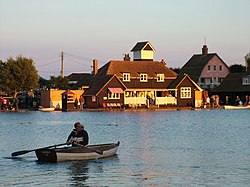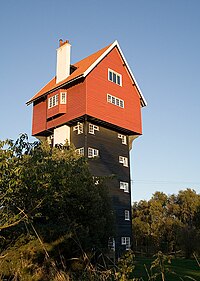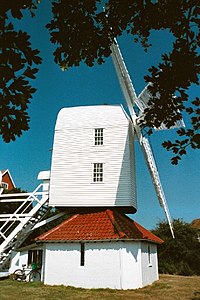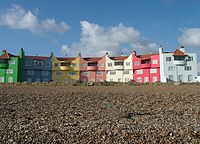Thorpeness
| Thorpeness | |
| Suffolk | |
|---|---|
 Thorpeness Meare | |
| Location | |
| Location: | 52°10’46"N, 1°36’53"E |
| Data | |
| Post town: | Leiston |
| Postcode: | IP16 |
| Local Government | |
Thorpeness is a village in the county of Suffolk. It is part of the parish of 'Aldringham cum Thorpe' (and is within the Suffolk Coast and Heaths Area of Outastanding Natural Beauty').
Contents
Development of the community
The village was originally a small fishing hamlet in the late 19th century, with folklore stories of it being a route for smugglers into East Anglia. However, in 1910, Glencairn Stuart Ogilvie, a barrister who had made his money designing railways around the world, bought the entire area from north of Aldeburgh to past Sizewell, up the coast and inland to Aldringham and Leiston.
Most of this land was used for farming but Ogilvie developed Thorpeness into a private fantasy holiday village, to which he invited his friends' and colleagues' families during the summer months. A country club with tennis courts and a swimming pool, a golf course and clubhouse and many holiday homes were built in Jacobean and Tudor Revival styles. A notable feature of the village is a set of almshouses built in the 1920s to the design of W.G. Wilson. To hide the eyesore of having a water tower in the village, the tank was clad in wood to make it look like a small house on top of a 5-storey tower, with a separate water-pumping windmill next to it. It is known as the "House in the Clouds", and after mains water was installed in the village the old tank was transformed into a huge games room with views over the land from Aldeburgh to Sizewell.
For three generations Thorpeness remained mostly in the private ownership of the Ogilvie family, with houses only being sold from the estate to friends as holiday homes. In 1972, Alexander Stuart Ogilvie, Glencairn Stuart Ogilvie's grandson, died on the Thorpeness Golf Course and many of the houses and the golf course and country club were sold to pay inheritance tax.
The Meare
An artificial lake, 'meare' or boating lake, was created, with many of its inspirations coming from a personal family friend, J M Barrie's work, 'Peter Pan'. Besides a large main pond, there are several channels with landings marked with names of the Peter Pan theme. Tiny islands on the Meare contain locations found in J M Barrie's novel such as the pirates lair, Wendy's home, and many others which children are encouraged to play on. The Meare was dug to a shallow depth for increased safety.
A variety of boats may be rented to enjoy the facility, many of which are original boats dating from the first creation of the Meare, and were named by the local workmen who had dug out the lake.
In August the Meare serves as the location for the Thorpeness Regatta which usually takes place around the same time as the carnival in neighbouring Aldeburgh and attracts many visitors. During the day boat races are held and at night boats that have been decorated are paraded around the Meare followed by a grand fireworks display.
Thorpeness today
Thorpeness is a quiet village of about 400 people in the winter, swelling to over 1,600 people in the summer holidays, the highlight being a regatta on the Meare at the end of August and a huge fireworks display. It is also a popular day trippers destination with its beach and Meare, amenities and sights such as the House in the Clouds, an unusual house, converted from a water tower in 1923.
The Ogilvies still have a strong presence in the village and many of the families coming there for their holidays have been doing so for generations. Also many of the families of the craftsmen who helped build the village are still there.
The village is now home to a small but thriving Thorpeness Rugby Club, the team who play their home games at the pavilion and sports ground are in the Eastern Counties Leagues. The club was reformed in March 2010 after beginning its time in 1973 but moving away in later years and finally closing in 1995.
Thorpeness has been voted as the 'Weirdest Village in England' by 'Bizarre' magazine in 2003.
To the south of the town lies the North Warren RSPB reserve. An area of wildlife and habitat conservation and nature trails run by the Royal Society for the Protection of Birds. It has Site of Special Scientific Interest (SSSI) and Special Protection Area (SPA) status.[1]
In popular culture
A lifeboat crew from Thorpeness rescues Tim and his friend the sea captain in the Edward Ardizzone book Little Tim and the Brave Sea Captain (1936), and are awarded medals for heroism by the Lord Mayor.
Thorpeness in the Second World War
- Radar: A radar installation was located in Thorpeness, Chain Home Extra Low Station K164.[2]
- A lone 18-pounder field gun was sited in a concrete gun emplacement on the cliffs of Thorpeness. The gun was named "John", and others elsewhere on the coast were named "Matthew", "Mark", "Luke" and "St. Peter". An anti aircraft battery was established too.[3]
- SS Magdapur fell victim to a mine and sank close inshore of Thorpeness.[4]
- An anti-tank ditch ran from Aldringham to the Meare. This was dug by the 9th Bn. of the Cameronians.[5]
- One regiment of the 1st Assault Brigade Royal Engineers was stationed in Thorpeness, arriving in late 1943.[6]
- From the RAF, a detachment of 2711 Squadron, RAF Regiment was stationed in Thorpeness,[7] as was 2783 Squadron RAF Regiment.[8]
Outside links
| ("Wikimedia Commons" has material about Thorpeness) |
- Thorpeness village
- Photographs and more details about Thorpeness
- Suffolk Coast and Heaths Area of Outstanding Natural Beauty
- Views along Thorpeness beach and of The Meare
- Thorpeness at nearthecoast.com ... it's a little bit Suffolk
References
- ↑ "The RSPB: North Warren". Royal Society for the Protection of Birds. http://www.rspb.org.uk/reserves/guide/n/northwarren/index.aspx. Retrieved 2010-05-17.
- ↑ National Monuments Record: No. 1478352 – Chain Home Radar
- ↑ University of York, Archaeology Data Service website. http://archaeologydataservice.ac.uk/archiveDS/archiveDownload?t=arch-415-1/dissemination/pdf/suffolkc1-184328_1.pdf
- ↑ Harwich and Dovercourt – Minesweepers
- ↑ http://pillboxesinsuffolk.blogspot.ae/2010/01/december-31st-decided-to-visit-anti.html
- ↑ BBC. http://www.bbc.co.uk/history/ww2peopleswar/stories/28/a2690228.shtml
- ↑ National Archives. http://discovery.nationalarchives.gov.uk/Details/AssetMain?iaid=C7159219
- ↑ National Archives. http://discovery.nationalarchives.gov.uk/details/r/C7159291


